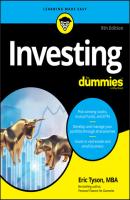Investing For Dummies. Eric Tyson
Чтение книги онлайн.

Читать онлайн книгу Investing For Dummies - Eric Tyson страница 21
Название: Investing For Dummies
Автор: Eric Tyson
Издательство: John Wiley & Sons Limited
Жанр: Личные финансы
isbn: 9781119716518
isbn:
Stocks can also pay dividends, which are the company’s sharing of some of its profits with you as a stockholder. Some companies, particularly those that are small or growing rapidly, choose to reinvest all their profits back into the company. (Of course, some companies don’t turn a profit, so they don’t have anything to pay out!) You need to factor any dividends into your return as well.
Suppose that in the previous example, in addition to your stock appreciating from $10,000 to $11,000, it paid you a dividend of $100 ($1 per share). Here’s how you calculate your total return:
You can apply this formula to the example like so:
After-tax returns
Although you may be happy that your stock has given you an 11 percent return on your invested dollars, remember that unless you held your investment in a tax-sheltered retirement account, you owe income taxes on your return. Specifically, the dividends and investment appreciation that you realize upon selling are taxed, although often at relatively low rates. The tax rates on so-called long-term capital gains (for investments held more than one year) and stock dividends are lower than the tax rates on other income. In Chapter 3, I discuss the different tax rates that affect your investments and explain how to make tax-wise investment decisions that fit with your overall personal financial situation and goals.
If you’ve invested in savings accounts, money market accounts, or bonds, you owe federal income taxes on the interest plus whatever state income taxes your state levies.
Often, people make investing decisions without considering the tax consequences of their moves. This is a big mistake. What good is making money if the federal and state governments take away a substantial portion of it?
If you’re in a moderate tax bracket, taxes on your investment probably run in the neighborhood of 30 percent (federal and state). So if your investment returned 6 percent before taxes, you’re left with a return of about 4.2 percent after taxes.
Psychological returns
Profits and tax avoidance can powerfully motivate your investment selections. However, as with other life decisions, you need to consider more than the bottom line. Some people want to have fun with their investments. Of course, they don’t want to lose money or sacrifice a lot of potential returns. Fortunately, less expensive ways to have fun do exist!
Psychological rewards compel some investors to choose particular investment vehicles such as individual stocks, real estate, or a small business. Why? Because compared with other investments, such as managed mutual and exchange-traded funds, they see these investments as more tangible and, well, more fun.
Savings and money market account returns
You need to keep your extra cash that awaits investment (or an emergency) in a safe place, preferably one that doesn’t get hammered by the sea of changes in the financial markets. By default and for convenience, many people keep their extra cash in a bank savings account. Although the bank offers the U.S. government’s backing via the Federal Deposit Insurance Corporation (FDIC), it comes at a price. Most banks pay a relatively low interest rate on their savings accounts. (I discuss banking options, including the sometimes higher-yielding online banks, in Chapter 7.)
Another place to keep your liquid savings is in a money market mutual fund. These are the safest types of mutual funds around and, for all intents and purposes, equal a bank savings account’s safety. The best money market funds generally pay higher yields than most bank savings accounts. Unlike a bank, money market mutual funds tell you how much they deduct for the service of managing your money. If you’re in a higher tax bracket, tax-free versions of money market funds exist as well. See Chapter 8 for more on money market funds.
Bond returns
When you buy a bond, you lend your money to the issuer of that bond (borrower), which is generally a government or a corporation, for a specific period of time. When you buy a bond, you expect to earn a higher yield than you can with a money market or savings account. You’re taking more risk, after all. Companies can and do go bankrupt, in which case you may lose some or all of your investment.
Generally, you can expect to earn a higher yield when you buy bonds that
Are issued for a longer term: The bond issuer is tying up your money at a fixed rate for a longer period of time.
Have lower credit quality: The bond issuer may not be able to repay the principal.
Wharton School of Business professor Jeremy Siegel has tracked the performance of bonds and stocks back to 1802. Although you may say that what happened in the 19th century has little relevance to the financial markets and economy of today, the decades since the Great Depression, which most other return data track, are a relatively small slice of time. Figure 2-4 presents the data, so if you’d like to give more emphasis to the recent numbers, you may.
Note that although the rate of inflation has increased since the Great Depression, bond returns haven’t increased over the decades. Long-term bonds maintained slightly higher returns in recent years than short-term bonds. The bottom line: Bond investors typically earn about 4 to 5 percent per year.